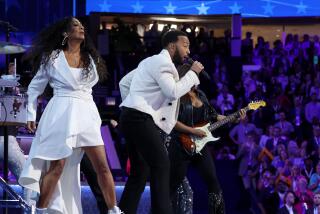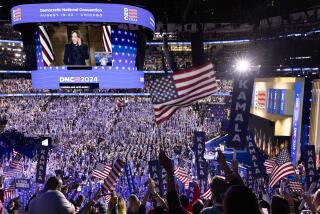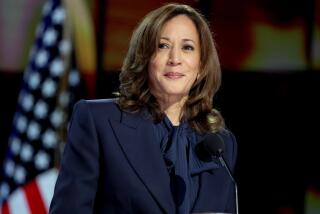Staples Center Gets a 21st Century Face Lift for Convention
The Lakers season may be over, but signs of the champions still permeate the locker room where Bob Kelty and his Democratic National Convention Committee team have set up shop.
On one shelf there’s a high-top sneaker the group has decided must be Kobe’s, because at size 18, it’s too small to be Shaq’s. Interview times are scribbled next to each player’s name on a board nearby. Sweat-stained furniture lines the floor, making team photographs hanging on the walls almost jump to life.
“We don’t even smell it anymore,” joked one staffer of the players’ hangout where she and 18 workers spend most of their waking hours these days.
The rest of Staples Center, however, bears scant resemblance to the arena where the Lakers scored points before an adoring throng in June.
During the past four weeks, construction crews have removed thousands of seats and built a huge wooden platform along one side, giving the oval-shaped arena a more intimate feeling. Under the new configuration, delegates and journalists will also get a better view of Democratic dignitaries and icons who will in two weeks gather at the national convention here.
Amazingly enough, hall manager Kelty’s first choice for a location from which to manage the sports arena’s conversion into a political convention hall was the windowless, stale-aired locker room.
It’s good karma, he said. Look at the precedent--President Clinton won reelection after the last convention held in the United Center in Chicago, the same place the Bulls captured the NBA championship title that year.
Except for recent concerns raised by African American contractors who felt shut out of the construction work the convention has brought to Los Angeles, preparations appear to be going smoothly.
A few visitors are allowed a peek inside Staples Center on the condition they not reveal too many details of what they see before the Aug. 14-17 convention. It’s supposed to be a surprise, organizers explained.
Amid scaffolding, red, white, blue and platinum paint shine beneath light fixtures that production director Tom Gorman said will ultimately number 14,500 and provide 1.5 million watts of stage lighting.
The convention colors clash with the purplish seats, but no one will see them once the delegates sit down, the builders said.
Outside Staples Center, workers are laying, splicing and stripping more than 300 miles of cable to accommodate hundreds of journalists and unprecedented Internet access to a political convention.
The Department of Water and Power is installing giant solar panels on the Los Angeles Convention Center next door, which will ultimately make it the largest solar-powered facility in North America. The panels are expected to generate 15% of the political convention’s electricity, said Lydia Camarillo, the convention committee’s chief executive officer.
Convention Design Reflects the Future
Making the convention’s infrastructure a dazzling, technological marvel will be key to its success, Democratic National Committee Chairman Joseph Andrew said.
By August in a campaign year, some voters don’t feel there is any real difference between the two parties, which makes conventions that much more important to a presidential ticket’s success, he said.
Unlike NBA championships, there’s little mystery as to the outcome.
“There’s very little breaking news,” Andrew said. “It’s all about the brand. The brand of Democrats, the brand of Republicans.”
His goal, Andrew said, is to give voters the opposite of what they’ll see at the Republican convention that starts today in Philadelphia, one “suspiciously male and pale,” with an emphasis on history.
So the Democrats are taking a futuristic approach to their $50-million convention; from 360-degree cameras that will provide every possible vantage point for Internet users, to platinum paint, to solar power and hundreds of alternative-fuel vehicles to shuttle delegates around.
Even the decision to host the convention in Los Angeles, whose residents represent a rich mix of colors, cultures and languages, highlights the Democratic message of looking ahead, Andrew said.
“We want a convention that looks like America in the 21st century,” he said. “We literally have the most diverse delegations.”
Not everyone is convinced about the Democrats’ commitment to diversity, however, especially when it comes to reconfiguring Staples Center and the convention hall.
Scores of black business owners accompanied Rep. Maxine Waters (D-Los Angeles) to a July 15 meeting with Camarillo at her office in the Arco building downtown, demanding to know why the committee hasn’t hired more minority-owned businesses. Only $3 million of $13 million being spent on convention construction and related contracts had gone to minority or women contractors, and only a quarter of the smaller amount went to African Americans, according to several people in attendance.
“I don’t think it’s a question of racism,” one said. “It’s a question of mismanagement and disorganization . . . of never establishing a policy in terms of outreach” to minority business owners.
Waters could not be reached for comment. On Friday, Camarillo said 45% of the contracts let in connection with the convention have gone to minority- and women-owned businesses. Most also are going to union businesses, she said.
Building Links to the Community
Neither she nor her aides could immediately say how much money those contracts translated into. But a high-ranking convention committee official said Sunday that the amount awarded to African American business owners now stands at more than $1 million. More contracts will be going to minorities in coming weeks, added the official, who has met with African American community leaders several times since the July 15 meeting.
Also, $3 million in contract money was deposited into three separate minority-owned banks when the convention committee first got to town in the spring, Camarillo said.
“We’re working to make sure we have the best possible opportunities available to all communities,” said committee spokesman Peter Ragone.
The main focus now is to complete preparations in the next two weeks, Camarillo said. She plans to visit the convention site almost daily to monitor the progress firsthand and meet with the 1,000 or so workers involved.
“This team is helping build an infrastucture that will help to decide America’s future,” Camarillo said. When it’s over, “Los Angeles is going to be very proud.”
More to Read
All things Lakers, all the time.
Get all the Lakers news you need in Dan Woike's weekly newsletter.
You may occasionally receive promotional content from the Los Angeles Times.







